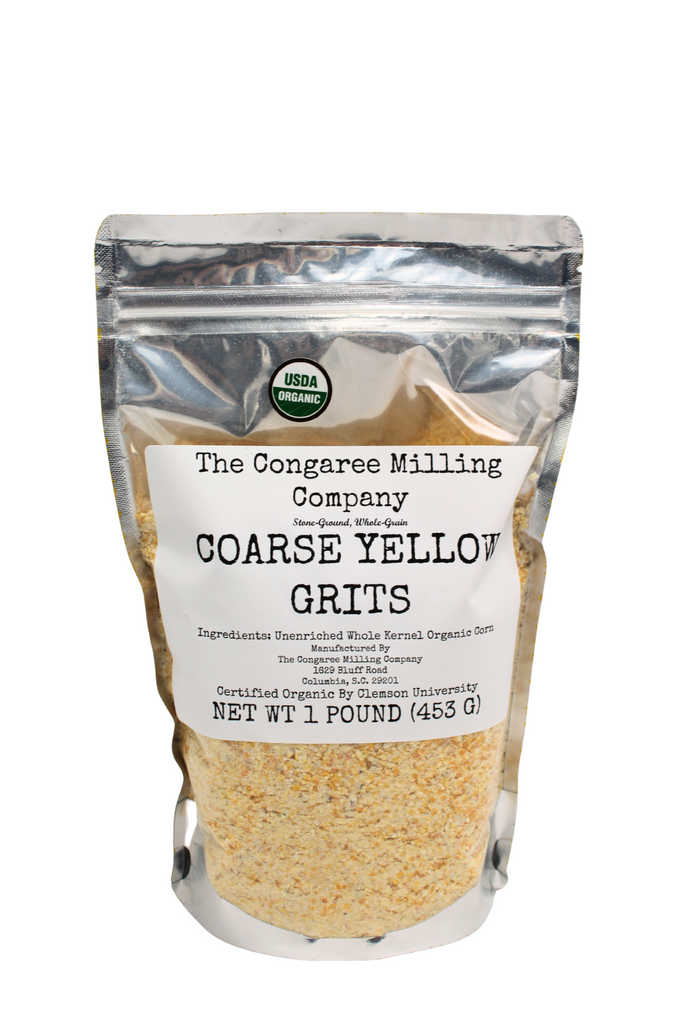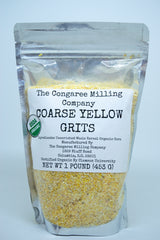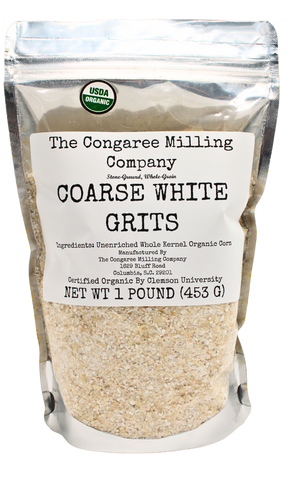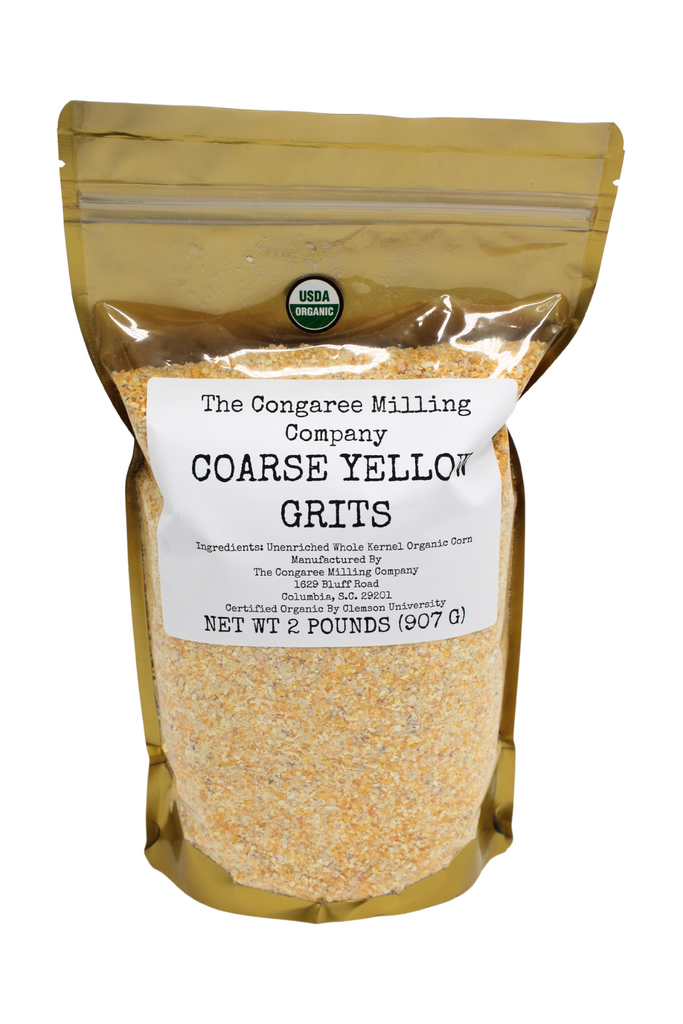Coarse Yellow Grits
$ 5.50
These organic, stone-ground Coarse Yellow Grits are milled in an old-fashioned frontier style. Freshly milled to order on our stone-burr mills, and shipped to your door. Made from organic yellow corn and nothing else, our grits are a vegan food. All of our products are artisanal, small-batch, and milled at our facility in Columbia, South Carolina.
Our Coarse Yellow Grits are also a whole-grain food, which makes them a great dietary source for resistant starch. Resistant starch plays an essential role in the health of the gut microbiome that is essential for health and weight regulation.
Our organic yellow corn has a robust fresh yet earthy corn flavor that holds up well as a lightly buttered cereal, or as a vehicle for spicy or creamy sauces. They can be reheated to good effect, or chilled, sliced, and fried.
Yellow corn contains vitamin A, while white corn does not.
Our products are USDA Certified Organic, and they are milled form domestic corn.
Here are some instructions on how to cook grits.
I always cook mine with a bit of salt and then add butter to finish. Grits are also delicious with some cheese.
Grits are ground up corn (Zea Mays). They are ground from dry field corn (not the sweet corn you eat on the cob during summertime). Field corn stays in the field until the kernels are dry enough to store without getting moldy (under 15.5% moisture content). Although field corn goes through the "milk stage" that sweet corn is harvested at, it is not sweet. It is instead starchy. Nixtamalized corn is also field corn.
This product is also vegan. It is a GMO-free and gluten-free product. Our Coarse White Grits are completely plant-based.
Whole-grain foods contain a significant portion of the entire kernel, seed, or groat of the grain in question. The different parts of a kernel of corn include the pericarp, the endosperm, and the germ (among many other constituent parts). From a nutritional standpoint the bran and germ are where it's at.
The Harvard T.H. Chan School of public writes on their website in regards to whole-grain foods:
"...The bran is the fiber-rich outer layer that supplies B vitamins, iron, copper, zinc, magnesium, antioxidants, and phytochemicals. Phytochemicals are natural chemical compounds in plants that have been researched for their role in disease prevention. The germ is the core of the seed where growth occurs; it is rich in healthy fats, vitamin E, B vitamins, phytochemicals, and antioxidants. The endosperm is the interior layer that holds carbohydrates, protein, and small amounts of some B vitamins and minerals."
The following is a direct quote from HL Agro's website:
"Corn germ consists of 14% saturated fatty acids and unsaturated fatty acids as well. The part of it which is the protein consists of 51% glutelin, 37% globulins, 5% of zein and 7% quantity of non-soluble oils. Maize germ also have in them present a large content of amino acids, phytin, beta sitosterol and Vitamin E."
Whole-grain grits are a food very high in resistant starch, which is an underappreciated component of our diet in current nutrition discussions.
Here are some instructions on how to cook grits. Generally speaking, 4 parts liquid to 1 part dry grits works perfectly. Stock of your favorite variety (be it vegetable or animal) and any sort of milk or cream are nice, also. A blend of any or all of these liquids works well. And plain old water works fine, of course.
As for myself, I always cook mine with a bit of salt and then add butter to finish. From there you can take grits in more than a few directions, be it as a starch base for a meal, or even just a healthy whole-grain snack on its own.
Grits can be chilled, then cut and fried in any method. I've been enjoying the air fryer as of late.
Want to know more about grits? Read on!
So what exactly are grits? Provided the grits are not specifically rice grits, grits are always ground up corn (Zea Mays). They are ground from dry field corn (not the sweet corn you eat on the cob during summertime). Field corn stays in the field until the kernels are dry enough to store without getting moldy (under 15.5% moisture content). Although field corn goes through the "milk stage" that sweet corn is harvested at, it's not sweet--it's starchy. Nixtamalized corn is also field corn.
Gerard Paul at manyeats.com wrote a thorough but concise article about corn that covers the topic quite well. Please give it a read here.
"Stone ground" refers to the mill the corn is ground up with. That means the corn was ground on a stone burr mill. Offhand, I can think of four different kinds of mills: stone burr, hammer, roller, and flail mills are all used to grind a variety of grain. Stone-ground products are ground on a stone burr mill. A stone burr mill is not required to mill grits, but they would not be stone-ground without the stone-burr mill.
Gerard Paul at manyeats.com wrote a thorough but concise article about corn that covers the topic quite well. Please give it a read here.
"Stone ground" refers to the mill the corn is ground with. That means the corn was ground on a stone burr mill. Offhand, I can think of four different kinds of mills: stone burr, hammer, roller, and flail. Stone-ground products are ground on a stone burr mill. A stone burr mill is not required to mill grits, but they would not be stone-ground grits without the stone-burr mill.
"Stone burr" simply means that the grinding part of the mill is made from stone, i.e., rocks (although some manufacturers use synthetic stones in their mills). "Burr" refers to the carvings on the grinding side of the millstones, Our mills have Balfour granite stones.
A flat stone is not as good at grinding as a stone that has been shaped with a pattern to assist in grinding grain (referred to as "grist" by millers). This pattern is referred to as "lands" and "furrows." Lands are the high spots, and furrows are the low spots. These shapes interact to cut the grain into uniform sizes.
Millstones may be arranged in a horizontal or vertical fashion. One of the stones called the "runner stone" spins. One stone is stationary, the "bedstone" or "set stone."
Modern stone burr mills are generally powered by electricity, but old-fashioned water-turned mills still count, as do the even more primitive horse powered mills, or even windmills. For that matter, human turned querns count also. As long as the grinding part of the mill is comprised of stone, the product being milled is stone ground.
To summarize: stone ground grits are corn that has been ground on a stone burr mill.
The Congaree Milling Company is a proud member of the SCSFA.
Check out this list of gristmills compiled by author Amy Halloran (thank you Amy!).
Here is a list of gristmills in South Carolina graciously compiled by SCIWAY.net. A very special thanks to Kerri.
We are also pleased to announce that Fundacion Tortilla was kind enough to include us in their directory of all things related to corn and nixtamal. Their primary focus is to preserve the diversity of indigenous corn culture. We are proud to be their allies.










Share this item: